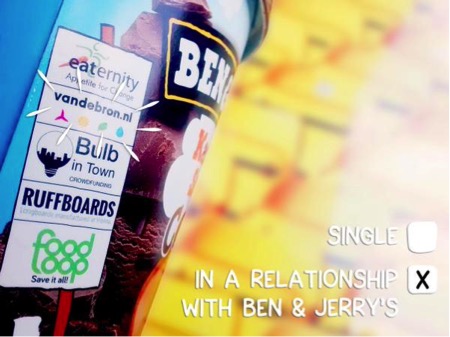Co-branding Relationships: Always a Love Story?
Relevant topics Archive, Advertising
Imagine you have just developed your own smashing brand. The story behind it is inspiring; while traveling through Nepal in the summer of 2015, just after the destroying earthquakes took place, you came across some homeless shelters for women. All these women were busy making beanies, hoping tourists would buy them. You decided to help them by creating a brand around it, with a full B Corp Certification.
You are convinced it will be a great success; how could anybody resist this lovely story, these marvellous beanies? However, after distancing yourself from your pink cloud eyesight, you realize there are lots of these caps on the market. How are you going to stand out in the crowd? Then you know what to do: create a co-branding relationship with a popular brand. This always works out great, right?
We All Know We Should Avoid these Pitfalls…
So, you are going to find a buddy for your brand and create the perfect match for success. In this process of searching a well-known brand to form a co-branding relationship with, you know there are some pitfalls to avoid.
Of course, you shouldn’t lose control over your product development and there should be no threat of potential product failure. A priceless example is Colgate, that wanted to extend its brand to Colgate Kitchen Entrees, hoping to enthuse customers to brush their teeth with Colgate toothbrush afterwards. Needless to say this idea already failed before they even launched…
If you’ve covered these risks you should also pay attention to the associations the established brand could transfer to your brand. Piece of cake; don’t go co-branding with a brand that brings up associations opposing yourself. An organic brand such as Earthbound Farm wouldn’t mingle with the likes of McDonald’s.
So far so good. Make sure your product is compelling, stay in control over the product development and choose a well-established brand that brings up positive associations and feelings in the customer’s mind. A brand that fits with your values. This is the formula to success, you think.
In the case of your beanies, you decided you want to build a co-branding relationship with Ben & Jerry’s. This seems to be the perfect match for you; a prominent Fair Trade brand that brings up positive associations, which will be transferred to your brand. A love story it will be.
Here’s The Real Game Changer
Unfortunately, like in every relationship, things are not that simple. Remember Sony Ericsson? Two great brands diving into a partnership, doomed to fail.
Whereas there exists a common belief that positively established brands nearly always do good to less-known brand evaluations, research proves this is not the case. There’s one powerful factor that determines the direction of a co-branding partnership with a well-established brand: timing. More specifically, the time gap in your ad between the moment both brands are shown together and the moment you announce the product’s biggest benefit.
How could such a small aspect determine the success of your co-branding relationship?
How This Small Change has Great Impact on Your Brains
Initially, the prominence of a well-established brand withholds the less-established brand from getting its share of positive associations. The subsequent product information gets overshadowed. As we are not able to process too much information at once, a certain competition arises in the brains of your customer, which causes them to neglect the less famous brand.
Putting in the recommended delay gives our brains some time to breathe and make the connections we need, be it consciously or not. This reverses the effects. Associations between the two brands are now strengthened, thereby positively influencing the evaluation of your brand.
Yes. Without a doubt, the real game changer in co-branding relationships is timing.
An example
To illustrate, let’s think about the campaign we would make with Ben & Jerry’s.
Picture this: a commercial, showing Ben & Jerry’s ice cream. Happiness automatically arises in your target group. Then your brand accompanies Ben & Jerry’s, demonstrating the partnership, immediately followed by the benefits of your product. You expect the positive feelings will be transferred to your beanies, straight away! Wrong. A commercial like this will probably even harm your brand.
Now let’s take a totally different approach. Ben & Jerry’s, followed by your brand, demonstrating the partnership. Now take a breath – give your audience some time to recuperate by putting in some fillers. At the end of the commercial: provide your product benefit. Done – the positive associations have been transferred and people will love your brand.
This is The Way to Co-Branding Success
So in the end, the message we want to give you is: just relax. Don’t go around shouting immediately all the great stuff your brand is up to. Give people the chance to make the right connections between your brand and the well-established one they already like, and your brand will soak up all positive associations. The timing of your co-branding info and product benefits will either make or break the co-branding partnership.
But what about print?
You can probably imagine how to use this principle in your advertising commercials. But how about print? We have less control over the sequence and timing of consumers’ attention here. To avoid cue competition, it’s best to avoid showing both your announcement about the partnership as well as the outcome information in the same printed ad.
A great example of a start-up showing its co-branding partnership with Ben & Jerry’s on print was that of vandebron, the Dutch ‘AirBnB for renewable energy’. Before going deeper into any benefits, they kicked off their campaign by simply showing their relationship. They gave their target group room for association-creating by easefully making them realize the similarities between the two companies. This being settled, the fireworks would soon follow…

Take home point:
- Put a time gap in your ad between the moment both brands are shown together and the moment you announce the product’s biggest benefit, this has a positively influence on the evaluation of your brand.

